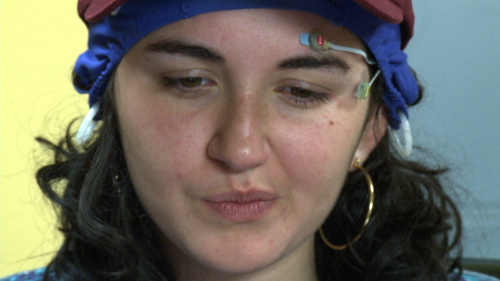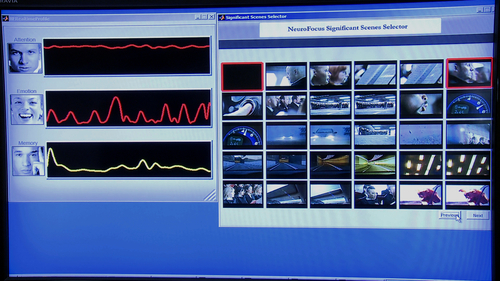Originally published on Turnstylenews.com, a digital information service surfacing emerging stories in news, entertainment, art and culture; powered by award-winning journalists .
By Maya Cueva
Say you're at Walgreens to buy shampoo. While browsing the hair product aisle, there's one bottle that calls out to you like a familiar face in an overwhelming array of hair tonic options. It just feels like... the ONE. Why is that?
If you believe the scientists doing research in the growing business of neuromarketing, it all comes down to what happens to your brain when you encounter an advertisement. Using the tools of neuroscience, these researchers and entrepreneurs say they can measure how a good ad grabs your attention to makes you aware of a certain brand. And, perhaps more lucratively, how a great ad triggers your emotions and primes you to be drawn to the brand when you encounter it again.

Which may sound scary to some people. But I've always thought my brain was different from other teenage brains. See, my therapist mom taught me from a young age never to surrender to the manipulations of advertising. When I was in second grade, she even started an after-school class where my classmates and I analyzed commercials and tried to spot product placements in our favorite TV shows.
"The kids were used to going into that zone where you just stop thinking and just watch," said my mom when I asked why she had developed the class. "This interrupted that, and made people stop watching and start thinking."
I, for one, started thinking a lot about ads, and really never stopped. But recently, I've been wondering if that critical thinking has made any difference and, in the end, just how much control I have over my own thoughts when it comes to ads. Which is how I ended up looking at my brain waves with A. K. Pradeep, a neuromarketing pioneer and CEO of the Berkeley-based company, NeuroFocus. Although it makes some scientists antsy, he tells advertisers how to make better commercials by replacing focus groups with an electroencephalogram.
"What neuroscience had done is taken us a step further," said Pradeep, "close to where the action happens, to where the truth really is."
NeuroFocus from Turnstyle Video on Vimeo.
To measure that action, Pradeep monitored the electrical currents in different parts of my brain as I watched a commercial - a Honda Civic ad that was chosen especially for my demo. Watch the video above to see Pradeep's analysis of how my brain responded to those images and sounds of zooming cars.
As you'll see in the video, this particular ad didn't make much of an impression. But one thing Pradeep and his team of neuroscientists made clear to me is that it did make some impression in my brain, and that even if I consciously try to resist commercials, they are getting in. A good one would prime my memory so that when it's time to buy, I would choose the company's product automatically.
According to the EEG readings, certain parts of my brain respond within milliseconds of when I see and hear an ad, well before the conscious part of my brain can have a say in the matter. That response appeared on the EEG as tall peaks in the parts of my brain NeuroFocus said are associated with emotion, attention and memory.

Advertisers can use this response data to compress a long TV ad down to a 10-second Web video for sites like YouTube. In theory, you'd see a high concentration of brain wave peaks per second as they pack this message into your head. But the question remains: what happens once it's in there?
"You can literally witness this battle going on," said Ben Hayden, a Duke University post-doc who uses functional magnetic resonance imaging, or fMRI, to look at decision making in primate brains. Hayden told me about researchers at Caltech who scanned the brains of people on diets while offering them their favorite junk foods. They saw lots of activity in upper parts of the brain when dieters exercised restraint.
That self-control region he says is in a tug-of-war with the kind of subconscious desires created by advertising.
"When an ad comes into the picture, it is kind of the opposite of self-control," Hayden said. "It gives an advantage to the lower parts of your brain, the ones closer to your eyes, and encourages you to just go out and buy it, just do it."
If you scanned my brain while I was in a shampoo aisle, Hayden's research suggests you'd see lots of activity in the "just do it" region as I automatically grab the brand that seems to call out to me. But just as TV ads prime that lower part of the brain, it turns out the kind of training my mom gave me could boost the "just say no" signal in my anterior cingulate cortex. It's what Mom was telling me all along.
I told my mom the results of all my neuroscience research - that despite all her training, ads would always enter my brain nonconsciously; that those nonconscious responses end up priming my brain to favor certain brands; and that in order to overcome that brand loyalty, my critical brain has to battle it out with deep-seeded desires. Then I asked her if she still thought that I could resist the sneaky power of advertising."Yes," she said matter-of-factly. "Because I know how thoughtful you are and how well educated you are."
OK, so maybe my mom is biased. But there's some neuroscience to back her up: Hayden says I could be better off than most teens, because every time I think critically about how ads work, I create new patterns in my brain that strengthen the self control regions. In other words, the ads might get inside my brain, but they don't have to decide what I do.
More Info:
Youth Radio Investigates is an NSF-supported science reporting series in which young journalists collect and analyze original data with professional scientists, and then tell unexpected stories about what they discover.
Turnstyle, an online news service launched by Youth Radio, hosted a conversation between Maya Cueva and her producer that takes you behind the scenes in the making of this story. Turnstyle surfaces emerging stories in news, entertainment, art and culture.
NPR airs a radio version of this story on June 14.